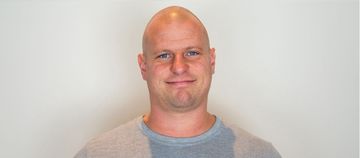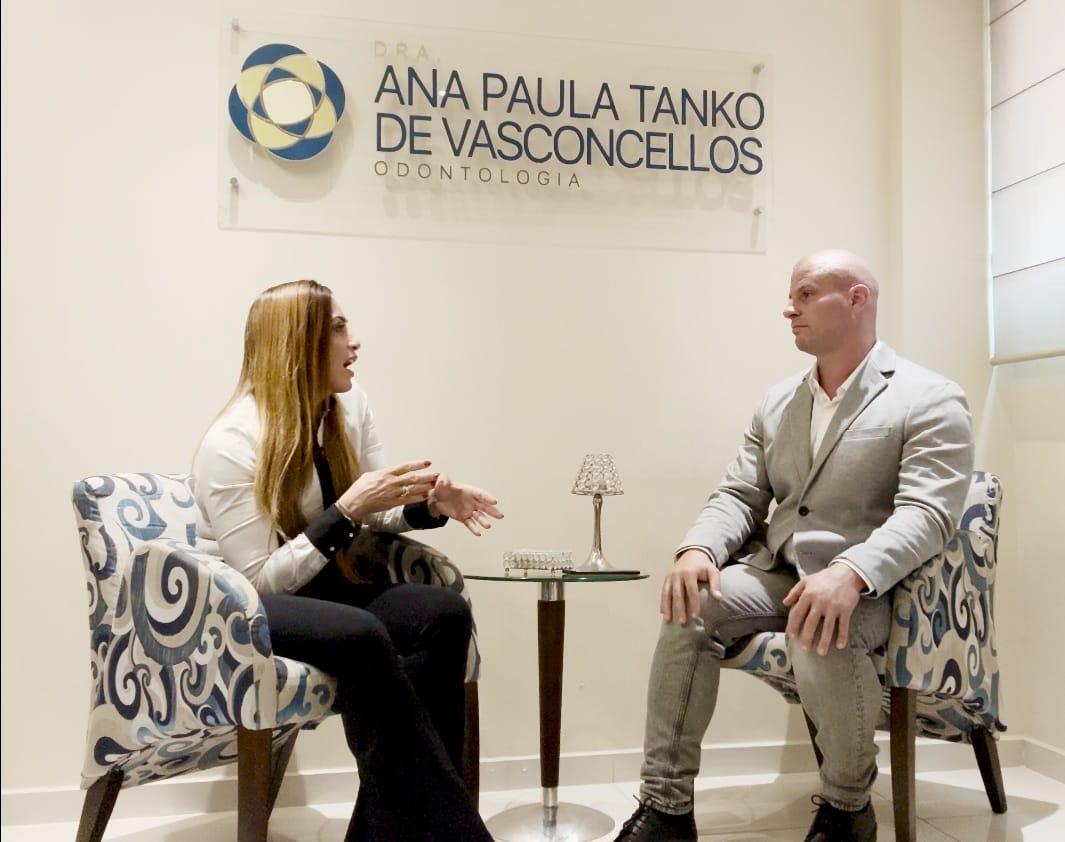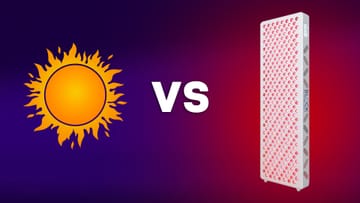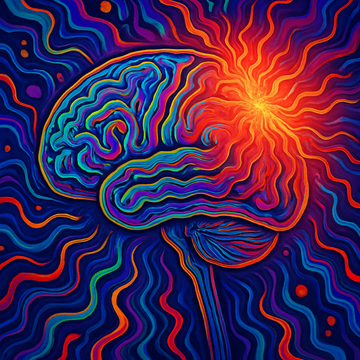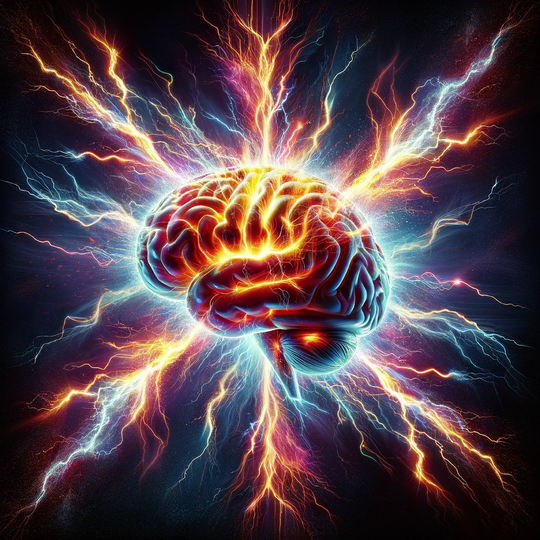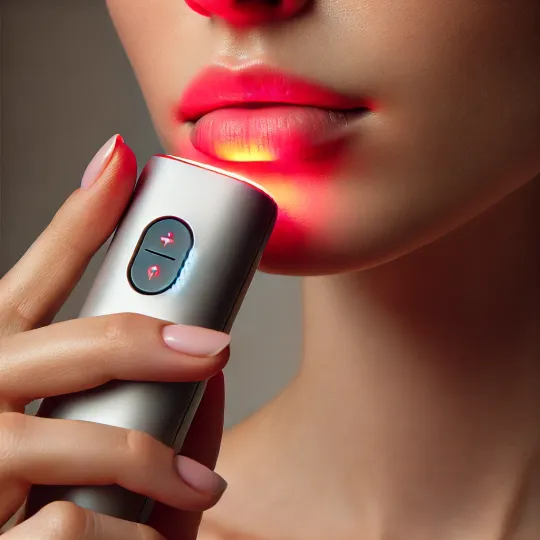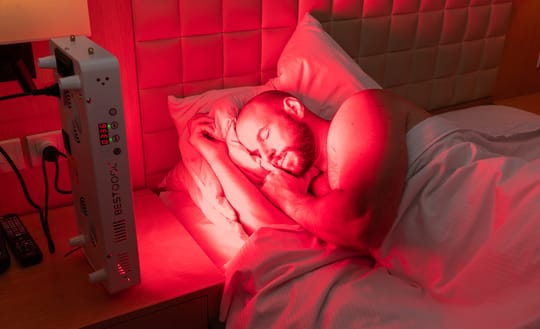Last November 2024, I took a trip to São Paulo, Brazil, for the World Federation of Laser Dentistry. There I met my good friend Dr. Ana Paula Tanko and visited her clinic the day after the event for an interview.
The interview is extremely interesting in my opinion because Dr. Tanko - as a dentist, oral surgeon, orthodontist, and with a specialization in orofacial harmonization - has been using red light therapy or "photobiomodulation" for my years now. Not only that but Dr. Tanko has provided me with some excellent pictures that showcase the clinical results you can get when you combine different therapies for the best results.
In my time in Brazil, I've found that many dentists there are far ahead of the West in implementing light therapy. Brazil is also one of the top-publishing countries regarding light therapy for dentistry, trailing just behind counties like the USA. The future of light therapy in dentistry is bright - both literally and figuratively - and below, we'll explore Dr. Tanko's vision of the future on this topic:

If you need an introduction to what these terms mean, check the following resources:
- What Is Red Light Therapy?
- Red Light Therapy Explained: Basic Terms Guide
- Start Here - Light Therapy 101 & Buyers Guide
- Red Light Therapy Dosing Chart: The Raw Data From Hundreds Of Studies
- Red Light Therapy Dosing: Why It's Complicated!
- Red Light Therapy Wavelengths Benefits: The Ultimate Guide
- How Often Should You Use Red Light Therapy Explained
These resources should give you a basic understanding of how red light therapy works, and the discussions around it!
Introduction: Photobiomodulation In Dentistry
Bart: "Hello, everybody. I'm here with my very good friend, Dr. Ana Paula Tanko. She is a wonderful dentist in São Paulo. We just attended the World Federation of Laser Dentistry yesterday and the last few days before.
But, Dr. Ana Paula Tanko is going to talk a little about her use of photobiomodulation in clinical practice. Welcome Ana Paula.
Dr. Tanko: Thank you very much for the interview.
Bart: First up, I want to ask you a little bit about your background and specializations. I would be very interested in that.
Dr. Tanko: I graduated in 1992 [as a dentist] here in São Paulo. After that, I did a specialization in dentistry in orthodontics, and in the last years, I worked with orofacial harmonization and attained that specialization. And, I also have a laser therapy specialization.
Bart: So, with orofacial harmonization, most people won't know what it means. Can you explain the basics of that?
Dr. Tanko: It's a specialization of Brazilian dentistry. That consists of procedures of harmonization of the teeth, gums, lips, and face, for both aesthetics and functional balance. That relies on procedures like Botulinum toxin, fillers, threads, biophotonics, and laser photobiomodulation.
Bart: So, everything is integrated, right? I saw your clinical cases.
Dr. Tanko: The functional and aesthetic balance of the person.
The Importance Of Jaw Position In Dental And Overall Health - Orthognathic Surgery For Better Dental Health And Breathing
Bart: Maybe it's important to emphasize as well, that you also adjust the structure of the jaw and the breathing area in the neck. It doesn't just look better it is also very beneficial for your breathing, right?
Dr. Tanko: The functional part is much more important than the aesthetic part. I call these procedures "morphofunctional treatment". The functional part is the chewing function and respiratory function. The treatment of the patient has to target his health. After that comes the aesthetics part - the morphology of the face. So, first the functional and after that the aesthetics.
Bart: People will have improvements in their breathing, chewing, and more.
Dr. Tanko: My specialization is also in orthodontics. Often, orthodontic compensation is applied before orthognathic surgery [- which is surgery of the jaw]. This orthognathic surgery is the most difficult part of the treatment. Because the time to treat a patient and prepare this patient before the orthognathic surgery is almost one year. The surgery with the patient takes about four hours.
Bart: And for the people who are reading this, the orthognathic is in the jaw.
Dr. Tanko: In the orthognathic surgery, there's a division of the face. There, we put the parts into the best position of both parts [the upper and lower jaw].
Bart: So it will improve the jaw structure and breathing.
Dr. Tanko: Yes. Both the chewing function and the respiratory function.
The Role Of Photobiomodulation Or Red Light Therapy In Dentistry: Caries, Periodontitis, Orthodontis, And More!
Bart: So now we're going to shift to another topic. During this entire process - during many of the interventions that you do as a dentist, orthodontist, oral surgeon, orofacial harmonization specialization, and you also use photobiomodulation or "red light therapy", right?
Dr. Tanko: The photobiomodulation is important for all the parts of the treatment. When I begin the treatment, I start with the health of the teeth and the health of the gums, and when I focus on this part, I very frequently use the laser.
For the health of the teeth, for example, I use photobiomodulation for the orthodontic treatment or gum treatment - it's very important.
Bart: For periodontitis or...
Dr. Tanko: Caries, or more. The photobiomodulation is essential. And, for example, the antimicrobial therapy, Photodynamic Therapy (PDT) for caries [PDT uses photosensitizer compounds that respond to light, such as methylene blue and others] is very good for caries. For endodontic treatment, photobiomodulation also gives very, very good results.
Bart: Just for the people who are listening, an endodontic treatment is when people get a root canal in a tooth.
Dr. Tanko: When I use an orthodontic treatment and you're moving the teeth, you must use a local application of the laser, for example.
Bart: When people have braces or something similar, then you use the laser?
Dr. Tanko: Yes. You use the laser for biostimulation for better overall function. Because I can only move the teeth if the bones underlying these teeth are healthy.
Photo-Dynamic Therapy (PDT), Methylene Blue, And Oral Health Applications
Bart: How about the Photodynamic Therapy (PDT) that you talk about? In PDT, you use a substance such as methylene blue together with light or another substance that reacts to light. And that PDT can then help with caries or with periodontitis I think.
Dr. Tanko: Yes, you have to use a photosensitizer. So, if you use a red laser, you must use a blue photosensitizer. But the opposite is true: if you use the photosensitizer in the red, you have to use a light source in the blue, for example.
And this is good to eliminate 99% of bacteria, viruses, fungi, it's very efficient, even more so than antibiotics.
Bart: For both caries and periodontitis.
Dr. Tanko: For infections or bacteria, for caries, for example, for Streptococcus mutans, Lactobacillus species, and for bacterial causes of periodontitis.
Photodynamic Therapy (PDT) For Periodontitis Protocol: Counteract Harmful Bacteria
Bart: Yeah, and can you give some examples of what patients notice? Like, say, I come here in the clinic and I have periodontitis and you do the PDT with me. What results can I expect? You have a 99% reduction in harmful bacteria. How long do the results last after one treatment? Or do you need to do multiple treatments, or?
Dr. Tanko: Good. When I work with orofacial harmonization, I work with a higher treatment frequency. The antimicrobial PDT, for example, if a patient of mine has a surgery called bichectomy [which removes excess fat from the jaw area] - this surgery can cause infections.
Bart: What is a bichectomy, for the readers/listeners?
Dr. Tanko: Bichectomy is a surgery to the face, to turn the face into a more triangular form, to achieve a more classical face. To improve the relationship between the middle third of the face and the lower third of the face.
So you go from a rounded face to a more triangular lower part of the face. This surgery has a high frequency of causing infections.
Bart: Ah, okay.
Dr. Tanko: After the surgery, if the person may have an infection then the photodynamic therapy works very well because the bacteria of the mouth are aerobics, enter inside the tissues of the face and turn into anaerobic behavior. That result is very bad. Antibiotics often don't have an effect on this type of infection.
Bart: And also because of the location?
Dr. Tanko: Yes, because of the behavior of the bacteria. That behavior is different inside the mouth than inside the soft tissues of the face. Because these bacteria cause negative pressure inside the tissues and the bacteria enter into the wound of the bishectomy surgery and cause infections.
Examples Of Orthognathic Surgery, Bichectomy, Orofacial Harmonization In Dentistry
Let's take a quick detour and consider some clinical examples here. Below you can see some of Dr. Ana Paula Tanko's personal results with orofacial harmonization and surgeries such as the bichectomy and orthognathic surgery to optimize her jaw structure:
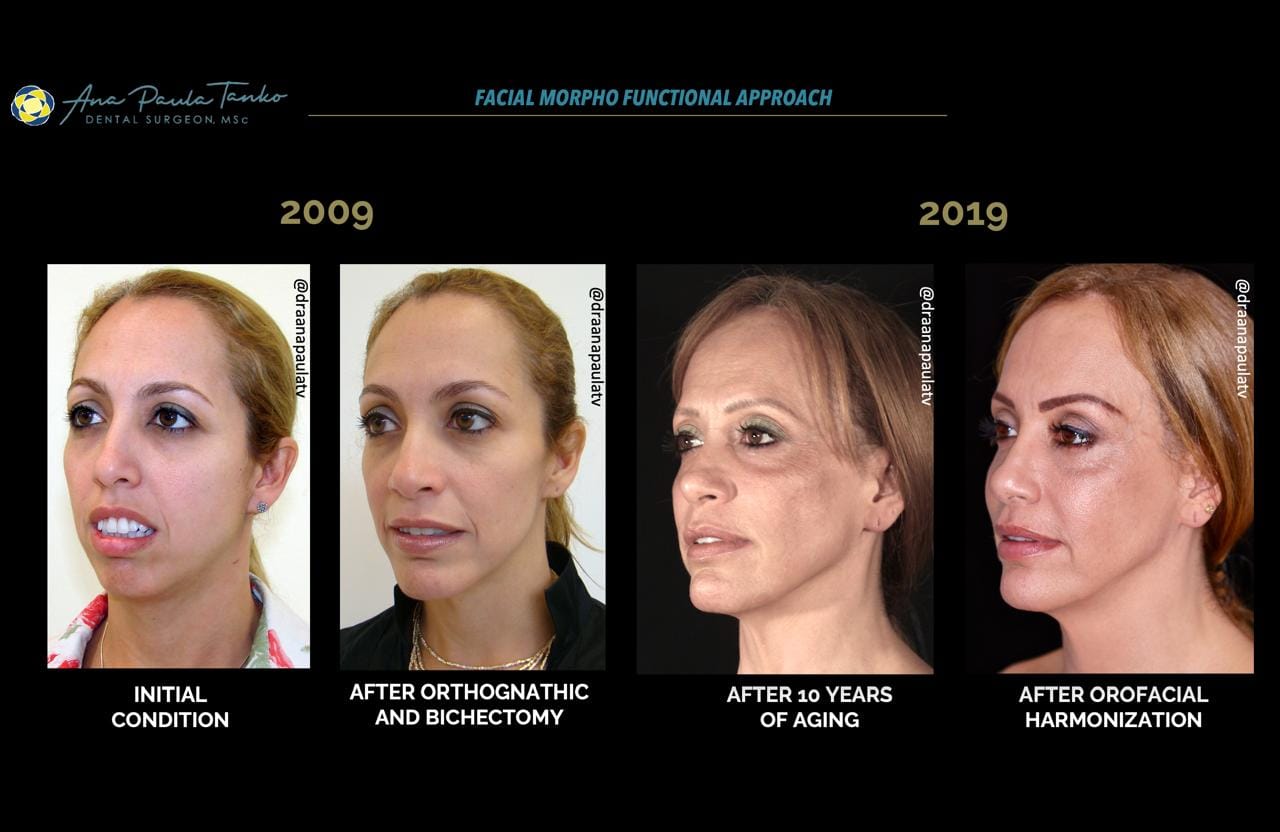
And:
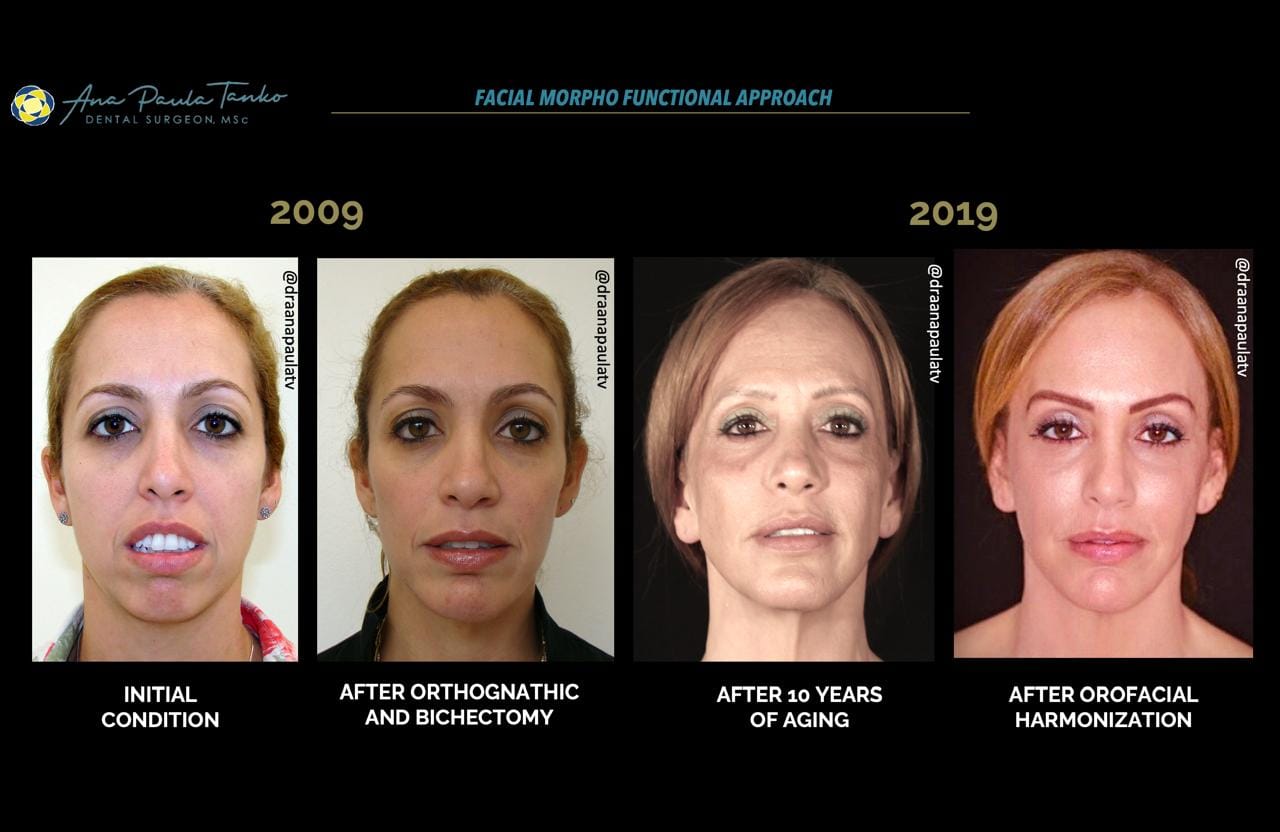
And:
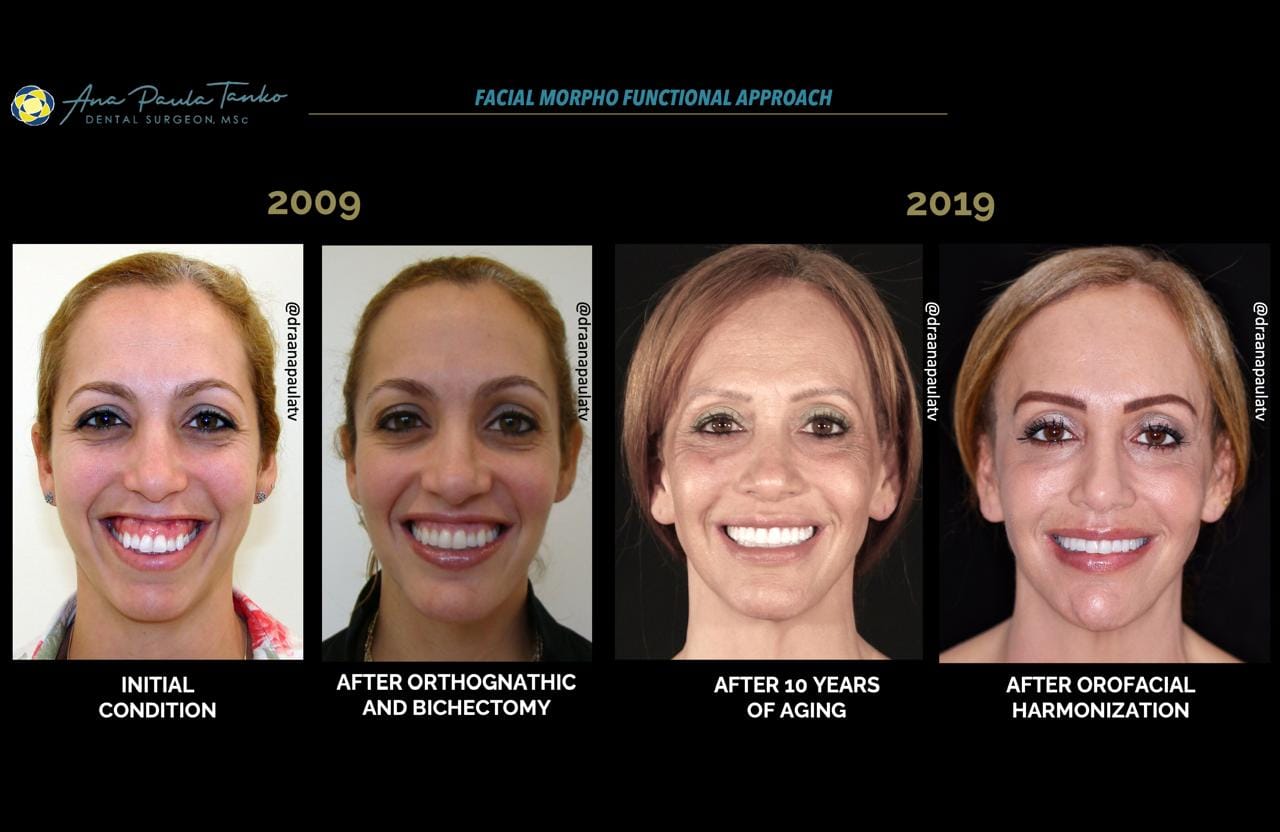
As you can see, these surgeries can completely transform the structure of your jaw and face, not only improving aesthetic appeal but also massively improving function, such as breathing and chewing. Dr. Tanko fixed the sleep apnea she had for decades, where she was unable to breathe correctly when lying down. Now Dr. Tanko can breathe while lying down because her airway structure got fixed.
Now, we go back to the interview:
Light Therapy On The Skin Before Orofacial Harmonization Treatments
Bart: And what kind of light do you use? I saw some of your presentations, and you use blue light, and you use amber, you use red, and near-infrared.
Dr. Tanko: I use different types of LEDs. And red and infrared lasers for the skin preparation, to receive the orofacial harmonization precedures. Because often, the patient's skin isn't in a very good state or healthy.
The skin is dehydrated, for example, or has melasmas. So, you must treat before applying the Botulinumtoxin and other protocols.
(I know that Dr. Tanko uses different procedures for the face, such as Botulinumtoxin, Hyaluronic acid injections, and more)
Using An Inexpensive Light Therapy Protocol To Counteract Melasma
Bart: So, I'm going to ask a little random question. Because we have many people in our Facebook group, there are like 18,000 people in there, and they have many questions, especially women - about melasma.
So, if you tell people, "I can successfully treat melasma", you will have many people coming to you in São Paulo!
Dr. Tanko: There are different ways to treat the melasma.
Bart: But you can treat the melasma?
Dr. Tanko: Yes, I treat the melasma when I do a protocol of orofacial harmonization.
[That laser treatment includes amber, red, and near-infrared light, among others]
For example, the patient wants to have a Botilunum toxin protocol to rebalance the muscles of the face and to cause a lifting effect of the face. To do it, you use the lifting threads.
Bart: And the threads, for the people who are listening.
Dr. Tanko: The threads lift the soft tissues of the face - to put it into an anterior position. Because of aging, you lose the positioning of the soft tissues of the face.
Bart: Yes, but for the people listening, the threads - and I've seen some of your videos - the people listening, the threads - we'll insert some videos here so people understand what we're talking about:
Comment: below you can see an example of threads being applied:
Dr. Tanko: I like to do a protocol for melasma. For example, using microneedling techniques, associative surface peeling that doesn't cause injuries, and combining that with the light (the photobiomodulation) in that strategy.
Bart: And what type of photobiomodulation do you use?
Dr. Tanko: I use the blue light for moisturizing the skin and to clear the skin. The amber light stimulates the collagen synthesis - that's very important to promote the collagen formation. Everyone wants collagen formation.
Then, I use the red laser and the infrared laser to reduce the inflammation.
Bart: And you can successfully fix most melasma cases with that?
Dr. Tanko: Yes, I show that in my clincal cases that I presented during the WFLD 2024 and the PBM 2024 congress.
Bart: But, just for my interest and that of the readers, can you get consistent results with that, with the melasma being reduced?
Dr. Tanko: Yes! You can have very good results with a simple and cheap treatment. That's very important.
Bart: Because microneedling is very cheap. And the lasers as well...
Dr. Tanko: Yes, microneedling is wonderful for that.
Bart: Of course, the product - the lasers - are expensive to buy, but once you have the device, the treatment is extremely cheap.
Dr. Tanko: Yes, and many treatments for the goal of reducing melasma are very expensive. And my protocol is very cheap. So it's a treatment that's cheap, simple, acceptable, and safe for all people. And, very, very effective, as I've shown.
Bart: Yeah, ok, wonderful!
Intravenous Photobiomodulation In Dentistry: Better Health, More Calmness, And Comfort
Bart: Next up, you don't just use local photobiomodulation that we've talked about before, such as for caries or periodontitis, but you also use systemic photobiomodulation?
Dr. Tanko: The systemic application of the laser is very good for the blood of the patient. In the UK, you have a center where you could see the results of the photobiomodulation of the blood, under a microscope. There, you can see what the intravascular laser therapy does for the blood.
Dr. Tanko: When you wake up and don't eat anything [so you're fasting] you can collect your blood and put it under the microscope. And you can see that the red blood cells don't clump and start to disperse better through the person.
When you have a hyperglycemic diet, you can see a disturbance of the red blood cells after fifteen or twenty minutes.
[Intravenous laser therapy with red light can counter hyperglycemia, improve microcirculation, and boost your insulin sensitivity]
The red blood cells are responsible for the oxygenation of the cells of your body. After you receive the intravenous therapy, then after 10 minutes, your cells are dispersed through your body again after hyperglycemia.
And, if you don't use intravenous therapy, this process will only be normalized again with hyperglycemia after 2.5 hours.
And with many dietary protocols for athletes, you have to eat every three hours. And that's not healthy because that's the time it takes for your cells to disperse again in your blood. The normal time for dispersion is 2.5 hours, so if you eat again, your cells can be more clumped together.
Bart: That's if you're hyperglycemic and eat a lot of quickly digested sugars.
Dr. Tanko: The intravenous light therapy has a very good systemic effect on your health. If you are healthy, you only have to apply it only one time per week.
Everyone who comes here gets the intravenous systemic laser therapy. You put the needle into your arm and the penetration of the laser will be very efficient for reaching your blood.
Bart: So all your patients receive the intravenous laser or only some? And in what context?
Dr. Tanko: Yes, here in my practice, all the patients receive the systemic laser. That's routine here in my practice. Not only for health but also they stay more calm and are more comfortable. I love the intravenous therapy.
Bart: That's very wonderful to hear!
Clinical Cases Of Dr. Tanko: Why The Health Of The Face Matters For Overall Health
Bart: Can you tell me more about your clinical cases? I saw a few of your clinical cases at the World Federation of Laser Dentistry 2024 yesterday and the day before. Can you tell me more about your thought process?
Dr. Tanko: I always consider and work with the health of the face. My main worry is the function first. The chewing function and the breathing function are why I am specialized in orthodontics.
Many times, patients have sleep apnea, and they don't know it.
Bart: Because most people who have sleep apnea don't know it.
Dr. Tanko: So the dental surgeon must diagnose and propose a treatment for the patient. That apnea is more critical here than aesthetics. The respiratory function, for overall health, is the priority.
After that, the main concern is the aesthetics of the face. Many times I propose the orthognathic surgery if the function of the jaws is incorrect. And that surgery is necessary if I cannot do an orthodontic compensation to correct the jaw structure and the teeth.

Because often, orthodontics cause injuries in the reticular part of the teeth, which comprises the future health of the teeth. Or, I can propose an orofacial harmonization protocol.
So, by correcting the foundation of the teeth first, the orthodontic intervention will thereafter have long-term success. Without proper jaw structure, orthodontic interventions may cause problems years or decades down the road.
Dr. Tanko: When I propose the orthognathic surgery, I have also apply orthodontic compensation of the teeth of the patient. Then, I consider orthodontic treatment only when the jaw structure has been corrected.
Many times, for aging patients, I only propose orofacial harmonization, Botulinum toxin, photobiomodulation, and lifting threads or fillers. And so on.
Bart: Ok, that's a very nice answer!
The Exciting Future Of Photobiomodulation In Dentistry: Better Infection Control And Cancer Treatment
Bart: Can you tell me about the future of photobiomodulation in dentistry, or "red light therapy" as it's more commonly called?
Dr. Tanko: I believe that the future of the treatment of infections will be with photobiomodulation. Photobiomodulation is fantastic for that. The anti-microbial Photo-Dynamic Therapy (PDT) is the future because it's more effective, more efficient for bacteria, and doesn't cause any antibiotics resistance.
PDT also doesn't cause any side effects. PDT works even with bacteria that are antibiotic resistant. Also, PDT has a broad spectrum and doesn't cause cytotoxicity.
So, I very much prefer to use PDT than to use antibiotics.
Bart: I very much understand, very nice answer! Are there any other cases where there is a case for PBM in dentistry? We saw many cases, of course, yesterday at the WFLD 2024.
Dr. Tanko: In dentistry, in the future, you can treat tumors more effective than with chemotherapy with PDT too. Because you can use the specific treatment protocol for the cancer cells so that only the cancer cells are affected, not normal cells.
So the future of dentistry is with the laser. For the local laser application, for the antimicrobial therapy for infections, for tumors, and to optimize your results. Becuase if you have healthy tissues you can have better results in dentistry, and with the aesthetic parts of the teeth and the aesthetics of the face. That's why photobiomodulation is so important for dentistry.
Bart: And there are, of course, many other cases where you can apply the light right? Such as dentin hypersensitivity, tooth extractions, and anything you can imagine almost.
Dr. Tanko: You can use the high-powered laser to remove veneers or crowns.
Bart: Without damaging the surrounding tissues, right?
Dr. Tanko: Yes, most injuries with the teeth are caused when you treat the ceramic parts of your teeth. There, fractures can occur, such as reticular fractures, or crown fractures, and you can lose teeth if there's a fracture in the reticular part.
Dr. Tanko: So, we can use a high powered laser again to make these procedures much safer.
Visiting Dr. Tanko For Dentistry, Photobiomodulation, Orofacial Harmonization, And More In São Paulo, Brazil
Bart: And the last question I wanted to ask, where can people find you? I see your very nice logo in the background of your clinic. You're also very active on social media.
Dr. Tanko: I have an Instagram account, which is @dranapaulatv - please follow me on Instagram.
Bart: And potential patients can also contact you there?
Dr. Tanko: Yes, on Instagram and my telephone number is there to contact me as a patient. You can also follow me on Facebook. But I prefer you contact me by phone or by Instagram
Bart: That's very nice! Thank you so much, Dr. Ana Paula,excellent for the wonderful information. And I hope to see you in 2025!
Dr. Tanko: Yes, thank you for the opportunity, and I hope to see you in 2025!
Conclusion: Laser Photobiomodulation In Dentistry Is The Future!
This is Bart here again. Let's reflect on this wondefful interview:
I hope you've seen a glimpse of the future of dentistry. My good friend Dr. Tanko's integrative approach of photobiomodulation in clinical dental practice is wonderful to see. Unlike many other dentists, Dr. Tanko emphasizes the functional importance of jaw structure for overall health, especially breathing and chewing. That jaw structure may need correcting with orthognathic surgery combined with orthodontic treatments.
It's great to see that Dr. Tanko uses photobiomodulation for a wide range of dental issues, including caries, periodontitis, and root canals, and employs Photodynamic Therapy (PDT) for its potent antimicrobial effects. Then there's the beauty aspect, with red light therapy for the face. Here, blue, amber, red, and near-infrared light are used. So, the final goal here is not just the teeth but the entire jaw and face, in both structure and aesthetic appeal!
The future of photobiomodulation in dentistry looks bright for different topics such as antimicrobial therapy, cancer treatments, caries, periodontitis, and anything you can almost imagine!
This article is based on the work of Dr. Ana Paula Tanko. Dr. Tanko is educated in:
- Specialist in Dentistry, University of São Paolo USP.
- Dental Surgeon, MSc, Faculty of Health Sciences, Albert Einstein Hospital FICSAE
- Specialist in Orthodontics by the Academy of Military Medicine of the Brazilian Army HMASP
- Specialist in Orofacial Harmonization, Faculty of Dentistry of the São Paolo Association of Dental Surgeons
- Qualification in Laser Therapy, Faculty of Dentistry of São Paolo Association of Dental Surgeons
- Postgraduate in Dental Implants. São Paulo Association of Dentists APCD
- Master in Teaching, Faculty of Health Sciences, Albert Einstein Hospital FICSAE
This is a post by Bart Wolbers of Light Therapy Insiders. Bart finished degrees in Physical Therapy (B), Philosophy (BA and MA), Philosophy of Science and Technology (MS - with distinction), and Clinical Health Science (MS), has had training in functional medicine, and is currently chief science writer.
Found This Interesting? Then You Might Like:
- Start Here - Light Therapy 101 & Buyers Guide
- Dental Red Light Therapy Before And After Case Studies From Clinical Practice
- Discount Codes, Deals & Recommendations - Red Light Therapy
- Red Light Therapy For Oral Health Ultimate Guide: 20 Unique Benefits!
- Oral Wound Healing With Red Light Therapy: Innovative Advancement?
- Dentin Hypersensitivity: Why Red Light Therapy Is A Game-Changer
- How Red Light Therapy In Dental Anesthesia Practices Shows Great Promise
- The Remarkable Role Of Light Therapy In Periodontal Care
